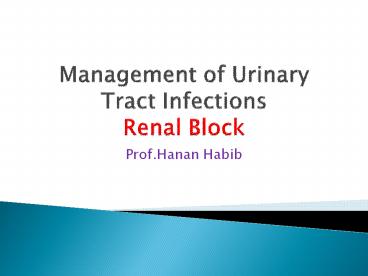Management of Urinary Tract Infections Renal Block - PowerPoint PPT Presentation
Title:
Management of Urinary Tract Infections Renal Block
Description:
Prof.Hanan Habib To eradicate the offending organisms from the urinary bladder and tissues. The main treatment of UTI is by antibiotics. Whether infection is ... – PowerPoint PPT presentation
Number of Views:267
Avg rating:3.0/5.0
Title: Management of Urinary Tract Infections Renal Block
1
Management of Urinary Tract InfectionsRenal Block
- Prof.Hanan Habib
2
Goal
- To eradicate the offending organisms from the
urinary bladder and tissues. - The main treatment of UTI is by antibiotics.
3
Choice of antibiotic depends on
- Whether infection is complicated or
uncomplicated. - Whether infection is primary or recurrent.
- Type of patient ( pregnant ,child , hospitalized
or not, diabetic patient,..etc) - Bacterial count.
- Presence of symptoms.
4
Uncomplicated UTI
- Low-risk patient for recurrent infection.
- 3 days antibiotic without urine test.
- Cure rate 94.
- Choice of antibiotic depend on susceptibility
pattern of bacteria, it includes - Amoxicillin ( with or without clavulanate)
- Cephlosporins ( first or second generation)
5
- Fluoroquinolone ( ciprofloxacin or norfloxacin)
- (not for pregnant women or children) ,first
choice if other antibiotics are resistant. - TMP-SMX ( trade names Bactrim, Septra
,Cotrimoxazole) - Nitrofurantoin ( for long term use)
6
Relapsing infection
- Caused by treatment failure or structural
abnormalities or abscesses. - Antibiotics used at the initial infection
- Treatment for 7-14 days.
7
Recurrent infections
- Patients with two or more symptomatic UTIs within
6 months or 3 or more over a year. - Need preventive therapy
- Antibiotic taken as soon as symptoms develop.
- If infection occurs less than twice a year, a
clean catch urine test should be taken for
culture and treated as initial attack for 3 days.
8
When to consult the doctor ?
- If symptoms persist
- A change in symptoms
- Pregnant women
- More than 4 infections per year
- Impaired immune system
- Previous kidney infections
- Structural abnormalities of urinary tract
- History of infection with antibiotic resistant
bacteria.
9
Postcoital antibiotics
- If recurrent UTI is related to sexual activity,
and episodes recur more than 2 times within 6
months - A single preventive dose taken immediately after
intercourse - Antibiotics include TMP-SMX, Cephalexin or
Ciprofloxacin
10
Prophylactic antibiotics
- Optional for patients who do not respond to other
measures. - Reduces recurrence by up to 95
- Low dose antibiotic taken continuously for 6
months or longer, it includes - TMP-SMX, Nitrofurantoin, or Cephalexin
- Antibiotic taken at bed time more effective.
11
Uncomplicated pyelonephritis
- Patients with fever, chills and flank pain ,but
they are healthy non-pregnant ,not nauseous or
vomiting with no signs of kidney involvement. - Can be treated at home with oral antibiotics for
14 days with one of the followings - Cephalosporins, Amoxicillin-Clavulanate,
Ciprofloxacin or TMP-SMX. - First dose may be given by injection
12
Continue-
- A urine culture may be obtained within one week
of completion of therapy and again after 4 weeks.
13
Moderate to sever pyelonephritis
- Patients need hospitalization
- Antibiotic given by IV route for 3-5 days until
symptoms relieved for 24-48 hrs. - If fever and back pain continue after 72 hrs of
antibiotic, imaging tests indicated to exclude
abscesses, obstruction or other abnormality.
14
Chronic pyelonephritis
- Those patients need long-term antibiotic
treatment even during periods when they have no
symptoms.
15
Treatment of specific populations
- Pregnant women
- High risk for UTI and complications
- Should be screened for UTI
- Antibiotics during pregnancy includes
- Amoxicillin, Ampicillin, Cephalosporins, and
Nitrofurantoin. - Pregnant women should NOT take Quinolones.
16
- Pregnant women with asymptomatic bacteriuria (
evidence of infection but no symptoms) have 30
risk for acute pyelonephritis in the second or
third trimester. - Screening and 3-5 days antibiotic needed.
- For uncomplicated UTI, need 7-10 days antibiotic
treatment.
17
Diabetic patients
- Have more frequent and more sever UTIs.
- Treated for 7-14 days with antibiotics even
patients with uncomplicated infections.
18
Urethritis in men
- Require 7days regimen of Doxycycline.
- A single dose Azithromycine may be effective but
not recommended to avoid spread to the prostate
gland. - Patients should also be tested for accompanying
STD.
19
Children with UTI
- Usually treated with TMP-SMX or Cephalexin.
- Sometimes given as IV.
- Gentamicin may be recommended as resistance to
Cephalexin is increasing.
20
Vesicoureteric reflux ( VUR)
- Common in children with UTI
- Can lead to pyelonephritis and kidney damage.
- Long-term antibiotic plus surgery used to correct
VUR and prevent infections. - Acute kidney infection use Cefixime (Suprax) or
2-4 days Gentamicin in one daily dose. Oral
antibiotic then follows IV.
21
(No Transcript)
22
Management of catheter-induced UTI
- Very common
- Preventive measures important
- Catheter should not be used unless absolutely
necessary and they should be removed as soon as
possible.
23
(No Transcript)
24
Intermittent use of catheters
- If catheter is required for long periods ,it is
best to be used intermittently. - May be replaced every 2 weeks to reduce risk of
infection and irrigating bladder with antibiotics
between replacements - Daily hygiene and use of closed system to prevent
infection.
25
Catheter induced infections
- Catheterized patients who develop UTI with
symptoms or at risk for sepsis should be treated
for each episode with antibiotics and catheter
should be removed, if possible. - Associated organisms are constantly changing.
- May be multiple species of bacteria.
26
continue-
- Antibiotic use for prophylaxis is rarely
recommended since high bacterial counts present
and patients do not develop symptomatic UTI. - ANTIBIOTIC THERAPY HAS LITTLE BENEFIT IF THE
CATHETER IS TO REMAIN IN PLACE FOR LONG PERIOD.































